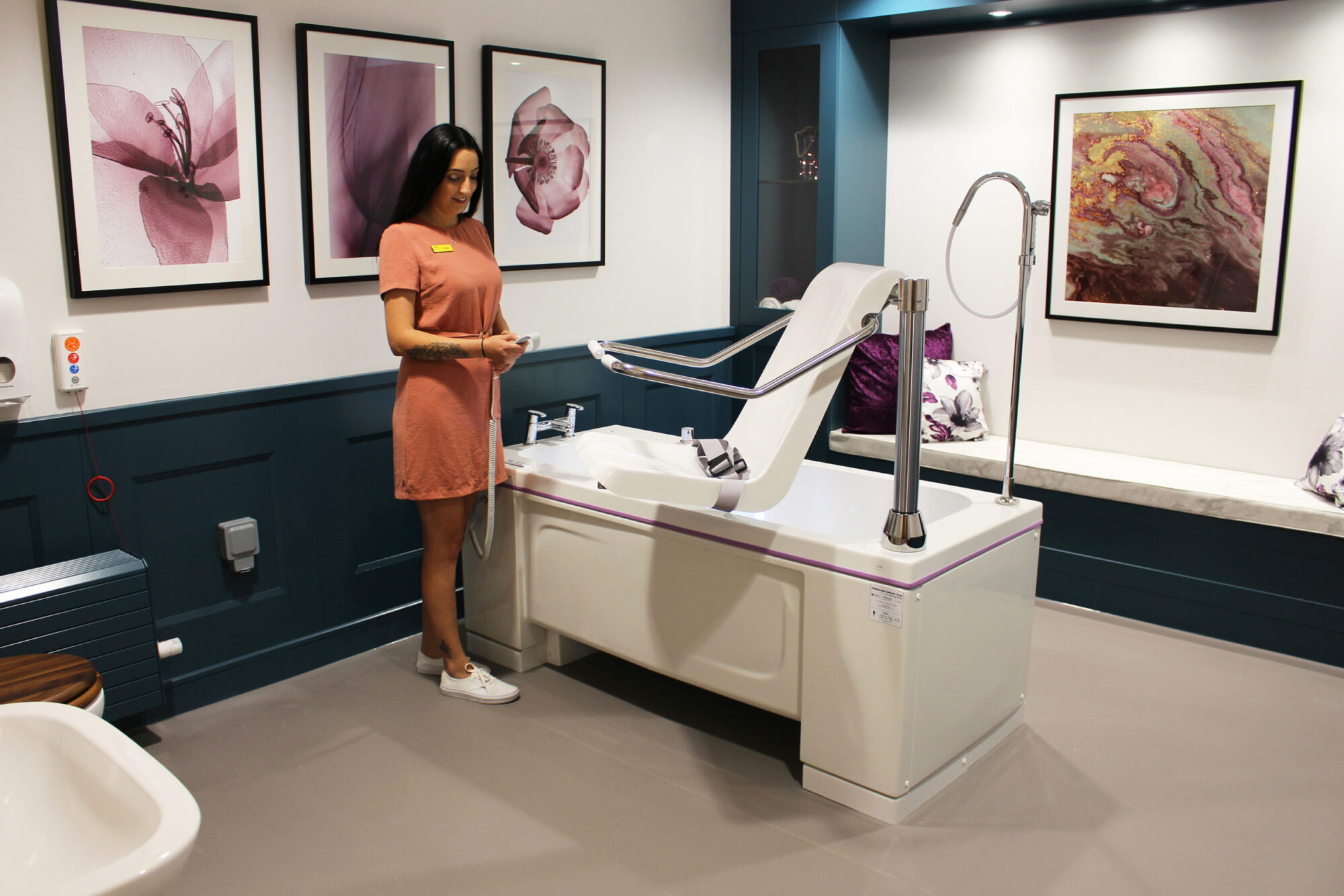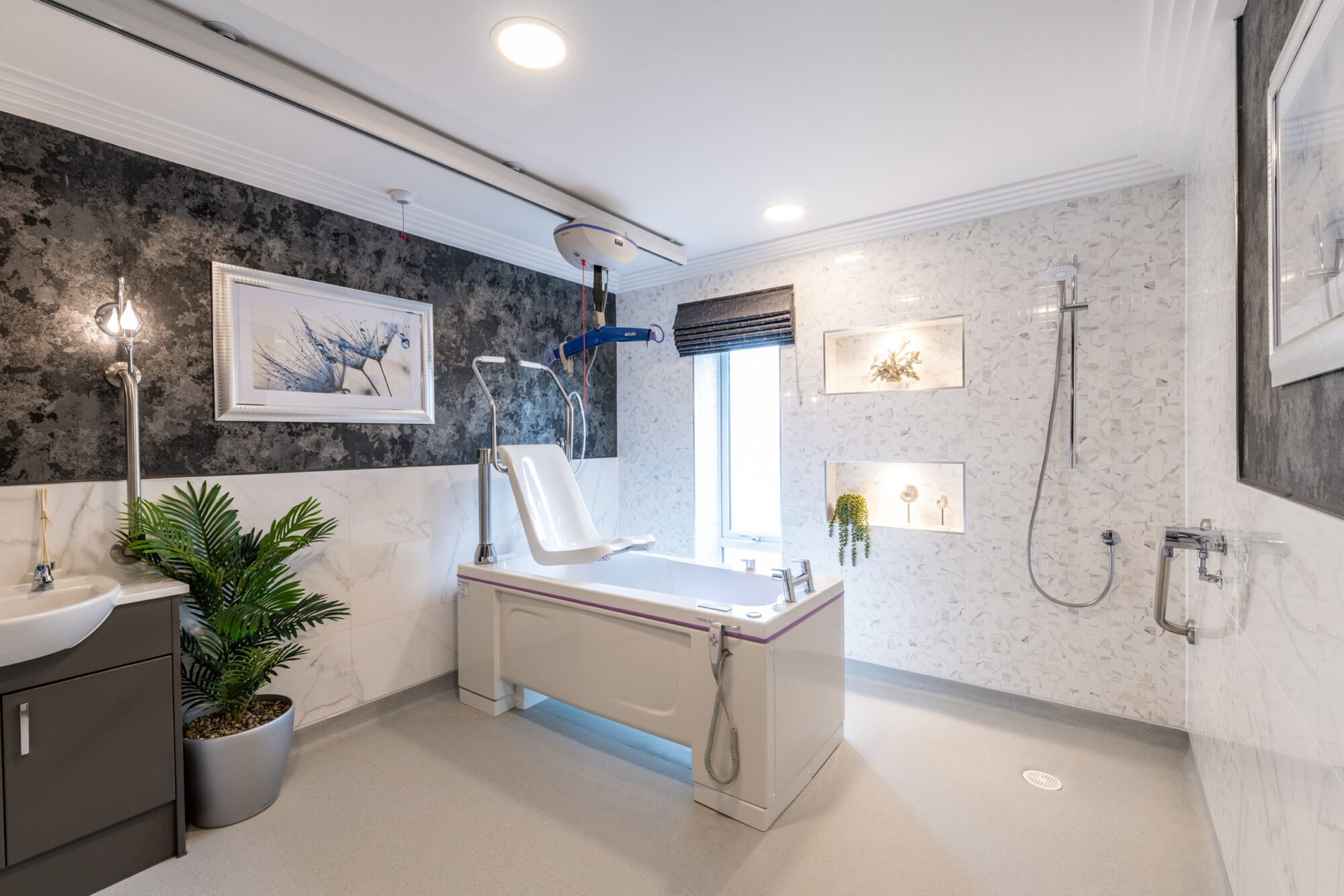Supporting the care home staffing crisis through specialist bathing equipment provision
During the devastating impact of Covid 19, the pandemic shone a light on the importance of the care industry. Yet in the wake of its most challenging period, the sector now faces a potentially alarming staffing crisis.
)
During the devastating impact of Covid 19, the pandemic shone a light on the importance of the care industry. Yet in the wake of its most challenging period, the sector now faces a potentially alarming staffing crisis. What can be done to gain and retain care industry employees and workforce longevity? Is there effective equipment available, such as assisted baths and bathrooms, to tangibly support the single-handed care demands placed upon staff?
The number of UK job vacancies is at a record high according to the Office for National Statistics. Data collected between August and September 2021 shows 23% of health sector organisations reporting vacancies as being more difficult to fill – compared to 13% across all industries. The annual Skills for Care workforce report suggested that unfilled UK care jobs were higher than pre-pandemic levels. And with its recent The state of health care and adult social care in England 2020/21, the Care Quality Commission (CQC) regulator warned of a “tsunami of unmet need”, with some care homes already withdrawing the provision of nursing care.
It’s a frustrating and worrying situation for care homes seeking to ensure the best support for residents who rely on their services. In addition, whilst the Covid vaccination programme has led to hopes that the worst of the pandemic is behind us, the compulsory mandatory jabs for care staff are feared to be worsening the already critical care workforce shortages.
These challenges in staff recruitment and retention, exacerbated by the reopening of the wider economy, are creating significant pressures and workload on existing care home employees. Employer feedback warns of staff experiencing ‘burn-out’ due to the strain of the pandemic, with a diminished workforce and more emphasis on single-handed care. Without the necessary supportive measures in place, such as quality assistive baths and adaptive equipment which champion smaller working teams, the pressures on remaining care staff may only grow – creating a situation where more leave as a result. Ultimately this creates a situation in which current residents lose out on quality time and individual one on one attention – and increases the numbers of hospital patients awaiting discharge to care homes in England due to a lack of care staff.
In October 2021, the government launched a workforce and recruitment fund to support the social care workforce, yet Ian Trenholm, Chief Executive of CQC, warns: “This year, more people than ever have contacted us with feedback and concerns about care. And as we go into winter, the health and care workforce are exhausted and depleted – which has clear implications for the vital care they deliver.’
Where other industry employees may have found respite from work during the Covid outbreak, such as through furlough or work-from-home schemes, care staff have faced relentless and difficult situations often resulting in low personal mental and physical health. And these challenges arising from the pandemic have added to existing pressures already experienced by care home staff.
According to 2019/2020 data published by the Health and Safety Executive (HSE), and derived from largely outside the Pandemic, work-related ill health in the human health and social work industries was ‘statistically significantly higher than that for workers across all industries.’ Fifty percent was attributed to stress, depression and anxiety, and a third to musculoskeletal disorders.

It is widely recognised that employees in the care sector, without access to specialist assistive equipment that underpins moving and handling best practices, are at higher risk of back and musculoskeletal injuries. Supporting clients physically to move around safely is a large part of a carer’s role, with many care home residents requiring assistance for bathing, dressing and other tasks involving moving and handling. Now consider that, according to the Skills for Care report, the average age for a worker in a care home with nursing is 44, and that musculoskeletal problems frequently become more common from our 30s and 40s onwards.
Ultimately it is not difficult to understand how with reduced staffing capacity, why back pain and inability to work may arise without the right equipment in place, such as a specialist bath and bather transfer chair, to support single-handed care practices. Without appropriate assistive equipment, the bathing experience, for example, can be an emotionally negative and physically challenging experience for both resident and carer – which detrimentally might lead to baths not being used at all.
In the long-term care sector, the need for safe bathroom processes is essential. An ageing UK population is widely documented and conditions such as MS, Parkinson’s, arthritis, and dementia that lead to limitations in physical and cognitive functioning, mean many care home and hospital residents are at high risk of falling. In fact, it is estimated that care home residents are three times more likely to fall than people living at home. Muscle weakness, reduced stability and eyesight changes play a part in higher risk of falls especially within badly designed and ill-equipped bathrooms. Slippery and uneven floor surfaces, toilets at the incorrect height, insufficient lighting, lack of safely secured handrails and ill-maintained transfer equipment such as wheelchairs and hoists, are just some of the risk factors.
To ensure fall reduction and enablement of safe moving and handling for dependent service users, care homes and acute care facilities are therefore increasingly seeking to replace outdated and conventional bath and shower rooms with suitably adapted wet rooms and accessible bathing facilities. The provision of an accessible well-designed bathroom, with specialist power-assisted baths, can provide many benefits especially in circumstances where care team numbers are under pressure.
Specialist anti-slip flooring, lighting for dementia clients, antimicrobial tiling grout for enhanced hygiene control, through to specialist bather transfer chairs and hoists are just some of the adapted bathroom solutions available to support a more efficient care process.
Proven powered baths with height-adjustment functionality can provide ease-of-use with greater control and support for single-handed care practices. Furthermore, efficient assisted transfers in and out of the bath can be assured without the need for manual lifting of disabled bathers and subsequent loss of dignity. There are a range of specialist bath designs available, which promote efficienct and effective care, and which include features such as variable height adjustment, bather transfer seats, reclining functionality and specialist sensory features that are beneficial to residents with Alzheimer’s or other types of dementia. When selecting the ideal bath, it is essential that healthcare providers fully consider the needs of service users, the care tasks in hand and how operational costs can be optimised.
In doing so, a well-equipped adapted care bathroom will ensure carers can implement moving and handling best practice without risk of personal injury during the transfer process, and subsequent sick leave. As Robert Myers, Head of Care Pathways at Ardale, who has commissioned specialist powered baths in all Ardale’s purpose-built care homes, explains: ‘The care of our residents is important, however, so is the support of our staff. Power assisted movement takes the stress out of bathing by eliminating moving and handling risks and potential back injury. Our team can also engage at eye level with bathers whilst providing personal care more effectively.’ Likewise, Angela Hunt, B&M Care Business Development Manager, says: ‘Here at St Brendans we provide high quality care for local authority and privately-funded residents. We are finding clients from the public sector are arriving with much higher needs, so it is essential we have the capabilities to manage and support them. This is where our powered baths are critical from a safety point of view.’
With physical lifting minimised, and transfers more manageable and less stressful, the number of required carers assisting a resident to bathe can also be safely reduced. Furthermore, specialist baths from proven manufacturers such as those from Gainsborough Specialist Bathrooms with antimicrobial technology built-in, can provide a positive solution for greater hygiene and safeguarding sustainable care. Since the introduction of the Health and Social Care Act 2008, and the Care Quality Commission, health and social care establishments have been implementing strategies aimed at breaking the chain of cross-contamination between sources of bacteria, patients, and their caregivers. In addition, care homes have been required to apply more stringent measures following the challenges presented during the pandemic. Strengthened measures are particularly important in communal accessible bathrooms, with high traffic multiple users, which present the risk of cross-contamination between bathers and carers. Hence, specialist bathroom solutions with inbuilt antimicrobial protection that limits microbe growth, and provides 99% 24/7 protection against influenza A H1N1, E.coli, Salmonella and CRO, CRE, VRE and MRSA are therefore now regarded as even more critical when facilitating a safe, accessible bathroom environment. By enhancing hygiene, we can support the drive to reduce staff absence caused by ill health.
Uptake and implementation of assistive equipment therefore should be greatly considered when addressing operational performance in care homes, tackling pressures on staff workload, and supporting a reduction in staff injury and sickness. As the Care Quality Commission stated in its aforementioned publication, The state of health care and adult social care in England 2020/21, the care workforce “cannot work any harder – they need support to work differently.”
Equally, by promoting improved occupational performance for residents though the installation of assistive bathing solutions, for example, carers are helping to achieve a more positive outcome for their clients.
The mental and physical health benefits of bathing, as opposed to adapted showering, are frequently reported. For care home residents, including those who may not have been able to access a bath independently for many years, a powered bath with multiple safety and therapeutic features built-in enables a more pleasant and relaxing bathing experience. As Robert Myers, Head of Care Pathways at Ardale, states, his team ‘regularly sees improved mood in residents after bathing and firmly believes it strengthens mental health and well-being.’
Much more than a way of keeping clean and maintaining hygiene, a warm soak for many care home residents can lead to improvements in day-to-day activities outside of the bathroom through enhanced sleep, improved mobility, and a reduction in pain. Ultimately, as a result, this can lead to lower staffing costs as residents require less intervention in the wider care home environment, due to an increase in independence, confidence, and wellness.
All healthcare providers understand they have a duty of care to ensure optimal support and dignity for clients. The current financial constraints and staff shortages can be addressed and bolstered through the help of appropriate equipment that delivers this utmost care to residents and carers, whilst maximising long-term budgets. Selecting quality and proven powered baths with cutting-edge design features, such as the range from Gainsborough for example, not only provides efficient safety and support to a reduced care team, but they also provide long-term cost savings through reduced water and energy use. This in turn reduces gas and electric overheads as lower hot water usage means less heating is required. Combined with faster filling and more efficient bather transfers, bathing cycle times are reduced so staff can attend to more residents in less time. Without compromising care, this reduces pressure on care teams and results in enhanced service provision around care sector establishments.
By taking the necessary investment steps to support carers and workplace demands, care home managers can more effectively safeguard morale and bolster staff retention, whilst preventing any secondary impact on service users that may arise when care staff experience burn out. In seeking ways to safely reduce workloads on a more long-term scale, through ergonomic, adapted bathroom equipment, for instance, the care home industry can boost operational efficiency and ensure single-handed care practices can be delivered more easily, safely, and effectively. Investing in specialist equipment is, in actual fact, a worthwhile and much needed investment in carer and service-user wellbeing.
About the author

Peter Eckhardt is Chief Executive of Gainsborough Healthcare Group, a total bathroom solution specialist which delivers assured care, safety and accessibility for semi-ambulant bathers, healthcare providers and moving and handling professionals. A UK specialist bath manufacturer, Gainsborough provides holistic products and services to the care industry through it leading brand Gainsborough Specialist Bathrooms. Peter takes pride in delivering a company ethos that is client-centric and based on the core values of ethics, diligence and integrity.
![Gainsborough Specialist Bathrooms [logo]](https://www.gainsboroughbaths.com/wp-content/themes/gainsborough-theme/assets/img/gsb-logo-white.svg)
